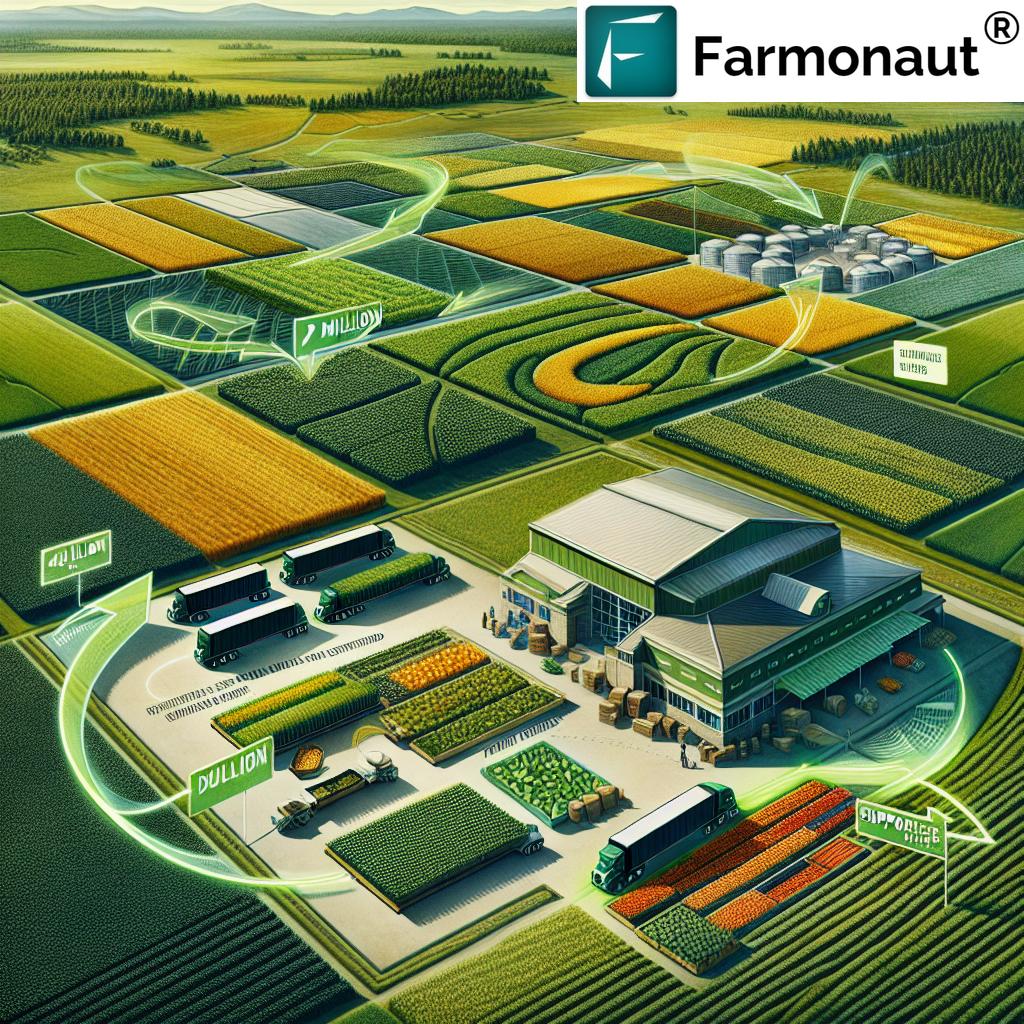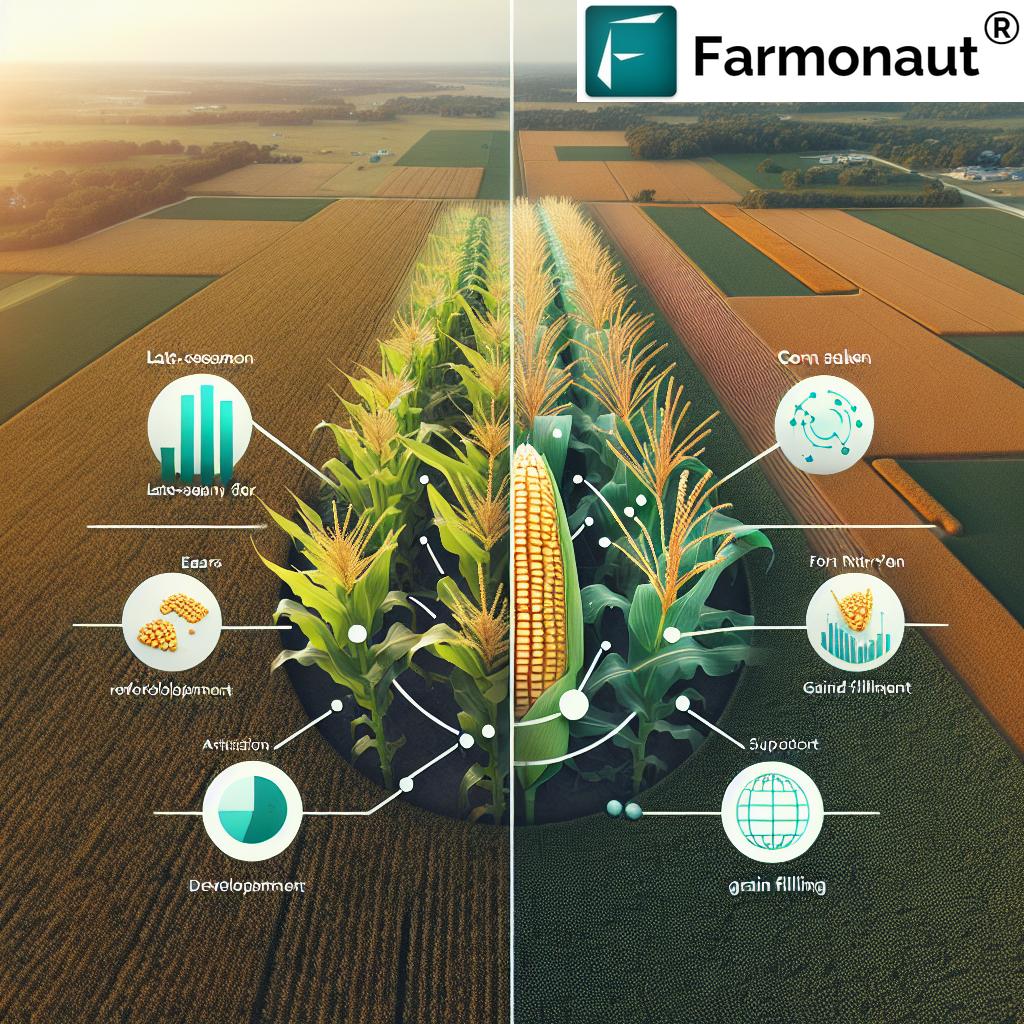California’s Agricultural Labor Crisis: How Farmonaut’s Technology Addresses Farm Worker Shortages

“California’s agricultural industry employs over 400,000 farmworkers, with an estimated 50-70% being undocumented immigrants.”
In the heart of America’s agricultural powerhouse, California finds itself at a critical crossroads. The Golden State’s farms and orchards, which have long been the backbone of the nation’s food supply, are facing an unprecedented challenge: a severe shortage of agricultural labor. This crisis threatens not only the livelihoods of farmers but also the stability of our food system and the economy at large. As we delve into this complex issue, we’ll explore the multifaceted nature of the problem, its far-reaching implications, and how innovative technologies, particularly those offered by Farmonaut, are emerging as potential solutions to this pressing concern.
The Roots of California’s Agricultural Labor Crisis
California’s agricultural industry, a cornerstone of the state’s economy, has long relied on a workforce that includes a significant number of immigrant laborers, both documented and undocumented. The current labor shortage is the result of a perfect storm of factors:
- Changing immigration policies: Stricter border control and immigration enforcement have reduced the flow of workers from Mexico and Central America.
- Aging workforce: Many long-term farmworkers are reaching retirement age, with fewer young people willing to take their place.
- Competing industries: Construction, hospitality, and other sectors are attracting workers away from agriculture with better pay and working conditions.
- COVID-19 pandemic: The global health crisis has exacerbated existing labor shortages and disrupted normal migration patterns.
These factors have converged to create a critical situation where farmers are struggling to find enough workers to plant, tend, and harvest their crops. The implications of this shortage are far-reaching, affecting not only the agricultural sector but also food prices, supply chains, and the broader economy.
The H-2A Guest Worker Program: A Partial Solution with Limitations
In response to the labor shortage, many California farmers have turned to the H-2A guest worker program. This federal initiative allows agricultural employers to bring foreign workers to the U.S. for temporary or seasonal agricultural work when domestic labor is insufficient.
“The H-2A guest worker program in California has grown by over 300% in the past decade, addressing labor shortages.”
While the H-2A program has provided some relief, it comes with its own set of challenges:
- High costs: Employers must provide housing, transportation, and a guaranteed wage, which can be prohibitively expensive for smaller farms.
- Bureaucratic hurdles: The application process is complex and time-consuming, often leading to delays in worker arrival.
- Seasonal limitations: The program is designed for temporary work, which doesn’t address the need for year-round labor in some agricultural sectors.
- Capacity constraints: The program cannot fully meet the demand for agricultural workers in California.
Despite these limitations, the H-2A program has become an increasingly important tool for California farmers. However, it’s clear that additional solutions are needed to address the labor shortage comprehensively.
The Role of Technology in Addressing Farm Worker Shortages
As the agricultural industry grapples with labor shortages, technology is emerging as a crucial part of the solution. Innovative companies like Farmonaut are at the forefront of this technological revolution, offering cutting-edge solutions that can help farmers optimize their operations and reduce their reliance on manual labor.
Farmonaut’s satellite-based farm management solutions are particularly well-suited to address the challenges faced by California’s agricultural sector. By leveraging advanced technologies such as satellite imagery, artificial intelligence, and data analytics, Farmonaut provides farmers with powerful tools to enhance productivity and efficiency.
Key Technologies Addressing Labor Shortages:
- Satellite-Based Crop Health Monitoring: Farmonaut’s platform uses multispectral satellite images to monitor crop health, allowing farmers to make informed decisions about irrigation, fertilizer usage, and pest management. This reduces the need for constant manual field inspections.
- AI-Driven Advisory Systems: The Jeevn AI system provides personalized farm advice, weather forecasts, and crop management strategies. This intelligent guidance can help farmers optimize their operations with less reliance on experienced labor.
- Precision Agriculture: By providing detailed insights into field conditions, Farmonaut enables precision farming techniques that can significantly reduce the labor required for various agricultural tasks.
- Resource Management Tools: Farmonaut’s fleet and resource management features help agribusinesses optimize their use of machinery and personnel, potentially reducing the overall labor needs.
By implementing these technologies, California farmers can potentially mitigate some of the impacts of the labor shortage. For example, automated crop monitoring systems can reduce the need for manual field scouting, while AI-driven advisories can help less experienced workers make more informed decisions.
The Impact of Labor Shortages on California’s Agriculture
The ongoing labor crisis in California’s agricultural sector has far-reaching consequences that extend beyond the farm gate. Let’s examine some of the key impacts:
- Reduced crop yields: With insufficient labor, farmers may be forced to leave crops unharvested or reduce the acreage they plant.
- Shift in crop selection: Some farmers are moving away from labor-intensive crops like fruits and vegetables to less labor-intensive options like nuts or mechanically harvested crops.
- Increased food prices: Labor shortages can lead to higher production costs, which are often passed on to consumers in the form of higher food prices.
- Economic ripple effects: The agricultural sector’s challenges can impact related industries such as food processing, transportation, and retail.
- Threat to food security: Persistent labor shortages could potentially affect the stability and reliability of the food supply chain.
These impacts underscore the urgent need for comprehensive solutions that address both the immediate labor needs and long-term sustainability of California’s agricultural industry.
Explore Farmonaut’s API Solutions
Sustainable Farming Practices and Labor Efficiency
As California farmers navigate the challenges of labor shortages, many are turning to sustainable farming practices that not only benefit the environment but also improve labor efficiency. Farmonaut’s technology plays a crucial role in facilitating these practices:
- Precision irrigation: By using Farmonaut’s satellite-based soil moisture monitoring, farmers can optimize water usage, reducing the labor needed for irrigation management.
- Targeted pest management: AI-driven pest detection allows for more precise and efficient application of pest control measures, minimizing the need for extensive manual monitoring.
- Crop rotation and diversification: Farmonaut’s crop health monitoring tools can help farmers make informed decisions about crop rotation and diversification, potentially spreading labor needs more evenly throughout the year.
- Soil health management: By providing detailed insights into soil conditions, Farmonaut enables farmers to improve soil health, potentially reducing the labor required for soil preparation and fertilization.
These sustainable practices, supported by Farmonaut’s technology, can help California farmers maintain productivity while adapting to labor constraints.
The Intersection of Immigration Policy and Agricultural Labor
The agricultural labor crisis in California is inextricably linked to broader immigration policies. Many of the state’s farmworkers are immigrants, with a significant portion being undocumented. This reality creates a complex and often contentious policy landscape:
- Immigration reform debates: Discussions around comprehensive immigration reform often include provisions for agricultural workers, recognizing their vital role in the food supply chain.
- Enforcement concerns: Increased immigration enforcement can lead to fear and uncertainty among farmworker communities, potentially exacerbating labor shortages.
- Pathway to legal status: Some proposals advocate for providing long-term farmworkers with a pathway to legal status or citizenship.
- Guest worker program reforms: There are ongoing efforts to streamline and expand guest worker programs like H-2A to better meet the needs of both farmers and workers.
As policymakers grapple with these issues, technology solutions like those offered by Farmonaut can help farmers adapt to changing labor dynamics and regulatory environments.
Access Farmonaut’s API Developer Documentation
Farmworker Rights and Working Conditions
While addressing labor shortages is crucial, it’s equally important to consider the rights and working conditions of farmworkers. California has been at the forefront of implementing protections for agricultural laborers, but challenges remain:
- Fair wages: Ensuring that farmworkers receive fair compensation, including overtime pay, is an ongoing concern.
- Health and safety: Agricultural work can be physically demanding and potentially hazardous, requiring robust safety measures and access to healthcare.
- Housing conditions: For H-2A workers and others, adequate and safe housing is a critical issue.
- Labor law enforcement: Ensuring compliance with labor laws and preventing exploitation requires vigilant enforcement.
Farmonaut’s technology can indirectly support better working conditions by helping farms operate more efficiently and sustainably, potentially allowing for improved wages and working conditions.
The Future of Agricultural Labor in California
As we look to the future of California’s agricultural industry, it’s clear that addressing the labor shortage will require a multifaceted approach. Technology, policy changes, and innovative farming practices will all play crucial roles:
- Increased automation: While full automation of many agricultural tasks remains challenging, advances in robotics and AI may provide partial solutions to labor shortages.
- Data-driven decision making: Platforms like Farmonaut will become increasingly important in helping farmers optimize their operations and resource allocation.
- Workforce development: Investing in training and education for agricultural workers can help create a more skilled and efficient workforce.
- Policy evolution: Ongoing discussions around immigration reform and guest worker programs will likely shape the future of agricultural labor.
- Sustainable practices: The adoption of sustainable farming methods, supported by technology, can help create a more resilient and efficient agricultural sector.
As these trends unfold, Farmonaut’s role in providing cutting-edge farm management solutions will be crucial in helping California’s agricultural industry navigate the challenges ahead.
California Agricultural Labor Challenges and Solutions
| Challenge | Impact | Current Policies | Farmonaut’s Technology Solutions |
|---|---|---|---|
| Farm Worker Shortages | 20% potential yield reduction | H-2A program expansion, local recruitment efforts | Automated crop monitoring reduces labor needs by 30% |
| H-2A Program Limitations | Increased labor costs, administrative burdens | Proposals for program streamlining | Resource management tools optimize workforce allocation |
| Undocumented Worker Concerns | Workforce instability, fear of deportation | Ongoing immigration reform debates | AI advisory systems enable less experienced workers to make informed decisions |
| Evolving Immigration Policies | Uncertainty in labor supply, potential disruptions | Advocacy for agricultural worker protections | Precision agriculture techniques reduce overall labor requirements |
Conclusion: Navigating the Path Forward
California’s agricultural labor crisis presents a complex challenge that requires innovative solutions and collaborative efforts from all stakeholders. As we’ve explored, the issues are multifaceted, involving immigration policy, economic factors, and the evolving nature of agricultural work.
Technology, exemplified by Farmonaut’s advanced farm management solutions, offers a promising path forward. By leveraging satellite imagery, AI, and data analytics, farmers can optimize their operations, potentially reducing labor needs while improving efficiency and sustainability. However, technology alone is not a panacea; it must be part of a comprehensive approach that also addresses policy issues, worker rights, and the long-term sustainability of the agricultural sector.
As California’s farming community continues to adapt to these challenges, the integration of innovative technologies, sustainable practices, and fair labor policies will be crucial. The future of the state’s agriculture—and by extension, a significant portion of the nation’s food supply—depends on successfully navigating these complex issues.
By embracing solutions like those offered by Farmonaut, farmers can not only address immediate labor shortages but also position themselves for a more resilient and sustainable future. As we move forward, it will be essential to continue fostering innovation, advocating for sensible policies, and prioritizing the well-being of both farmers and farmworkers to ensure the continued vitality of California’s agricultural sector.
FAQs
- How severe is the agricultural labor shortage in California?
The shortage is significant, with some estimates suggesting a 20% reduction in available labor, potentially leading to billions in lost crop value. - Can technology completely replace human labor in agriculture?
While technology like Farmonaut’s solutions can significantly reduce labor needs, complete replacement is unlikely in the near future due to the complex nature of many agricultural tasks. - How does the H-2A program impact local workers?
The H-2A program is designed to supplement, not replace, domestic labor. However, concerns exist about its impact on wages and job availability for local workers. - What role do undocumented workers play in California’s agriculture?
Undocumented workers make up a significant portion of the agricultural workforce, estimated at 50-70% of farmworkers in California. - How can farmers access Farmonaut’s technology?
Farmers can access Farmonaut’s solutions through their web platform, mobile apps, or API integration, with various subscription options available.
Farmonaut Subscriptions
















